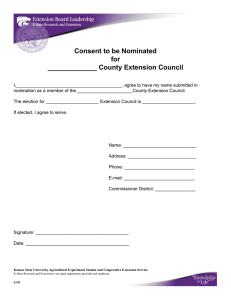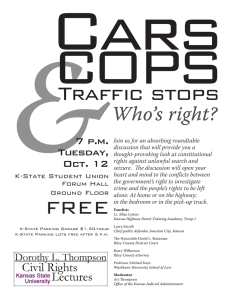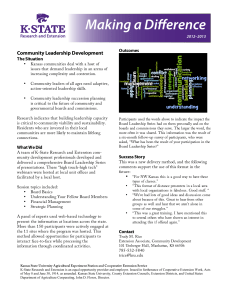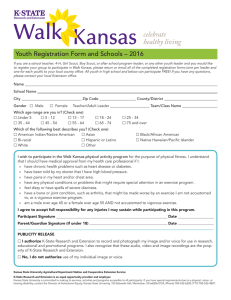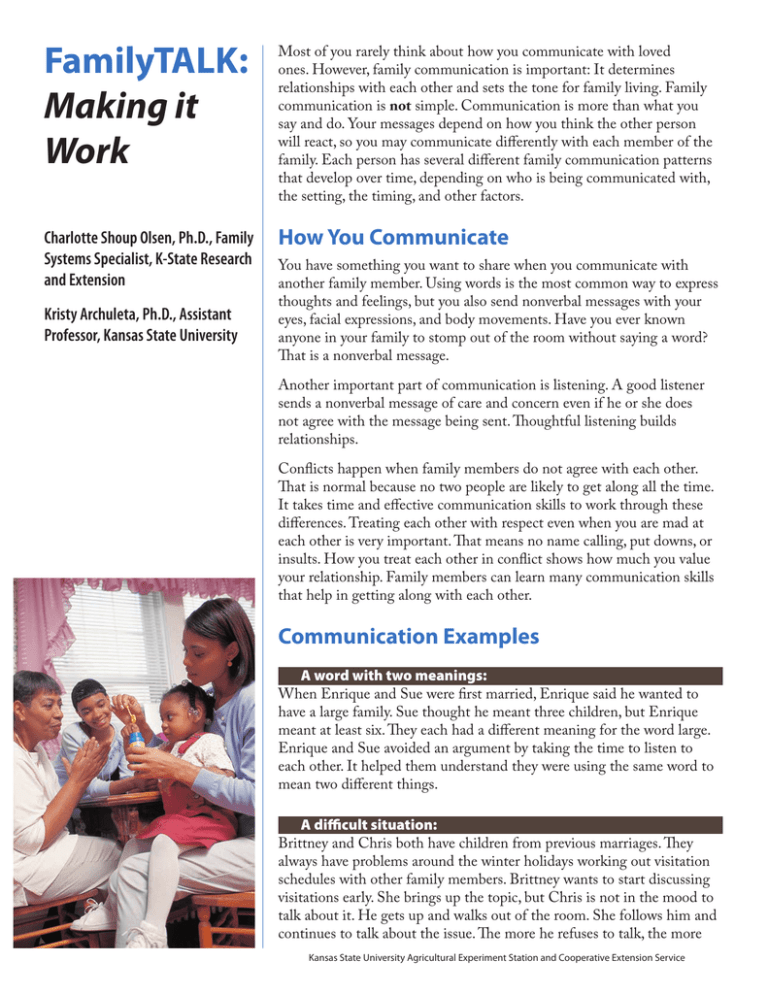
FamilyTALK:
Making it
Work
Most of you rarely think about how you communicate with loved
ones. However, family communication is important: It determines
relationships with each other and sets the tone for family living. Family
communication is not simple. Communication is more than what you
say and do. Your messages depend on how you think the other person
will react, so you may communicate differently with each member of the
family. Each person has several different family communication patterns
that develop over time, depending on who is being communicated with,
the setting, the timing, and other factors.
Charlotte Shoup Olsen, Ph.D., Family
Systems Specialist, K-State Research
and Extension
How You Communicate
Kristy Archuleta, Ph.D., Assistant
Professor, Kansas State University
You have something you want to share when you communicate with
another family member. Using words is the most common way to express
thoughts and feelings, but you also send nonverbal messages with your
eyes, facial expressions, and body movements. Have you ever known
anyone in your family to stomp out of the room without saying a word?
That is a nonverbal message.
Another important part of communication is listening. A good listener
sends a nonverbal message of care and concern even if he or she does
not agree with the message being sent. Thoughtful listening builds
relationships.
Conflicts happen when family members do not agree with each other.
That is normal because no two people are likely to get along all the time.
It takes time and effective communication skills to work through these
differences. Treating each other with respect even when you are mad at
each other is very important. That means no name calling, put downs, or
insults. How you treat each other in conflict shows how much you value
your relationship. Family members can learn many communication skills
that help in getting along with each other.
Communication Examples
A word with two meanings:
When Enrique and Sue were first married, Enrique said he wanted to
have a large family. Sue thought he meant three children, but Enrique
meant at least six. They each had a different meaning for the word large.
Enrique and Sue avoided an argument by taking the time to listen to
each other. It helped them understand they were using the same word to
mean two different things.
A difficult situation:
Brittney and Chris both have children from previous marriages. They
always have problems around the winter holidays working out visitation
schedules with other family members. Brittney wants to start discussing
visitations early. She brings up the topic, but Chris is not in the mood to
talk about it. He gets up and walks out of the room. She follows him and
continues to talk about the issue. The more he refuses to talk, the more
Kansas State University Agricultural Experiment Station and Cooperative Extension Service
she pursues the topic. Finally they both explode. Later they regret what
they said to each other. To protect their relationship, they have work to do
in learning new ways to communicate with each other.
Building Your Family Communication Skills
• Think about typical interactions among your family members,
including grandparents and other relatives. Review both the happy
times as well as the problem times. It helps to think how you can
increase the happy times while changing the times you clash with each
other. It is easy to think that the other family member should change.
Look seriously at yourself first to see what type of communication
patterns you are using — you have the most control over yourself in
changing family interactions.
• You can get carried away by thinking bad things about others when
there is a great deal of conflict. Stop yourself when negative feelings
and thoughts about other family members overwhelm positive
thoughts. Talk to yourself about the good qualities of other family
members. Think about the good times you have had together. Self-talk
is powerful for influencing your feelings and actions.
• Communication with family members involves talking, but listening is
also important.
• Effective listening is one of the best ways to show you care for the
other person. Effective listening builds trust, but takes patience and
hard work. This type of listening is more than hearing just the spoken
word. It allows you to understand what is actually said.
• A family member can tell when you are listening by noticing your eyes,
facial expressions, and body movements. Part of listening may be as
simple as saying, “Yes,” or “I see,” or nodding your head. Remember
that family members sometimes want a listening ear without advice or
judgment. Think about body language. What message are you sending?
Are you fidgeting? Rolling your eyes? Smiling sarcastically? Think
about your body position. Are you facing the speaker without being
too close or too far away? Are you sending a message that you are truly
listening?
• Effective listening does not mean you agree. You may not like what the
other person says. You are just trying to understand and identify with
the other person’s message. You may need to ask questions to get the
correct meaning of the intended message.
• One way to show you understand is to use your own words to repeat
the main points the other person has communicated. It is helpful to
try to identify the speaker’s feelings during this process. If you are
not correct in understanding the speaker’s emotions and message, you
need to repeat the process until the other person is satisfied that you
understand. Effective communication during a disagreement happens
when each person gets a chance to be listened to without interruption
and works hard at voicing feelings and the impact of the given
situation without blaming.
2
• Communication built on trust helps family members survive all kinds
of tough times. You know you can depend on each other. Having trust
also means that the communication patterns you use all the time show
care and respect for each other. You may not always agree, but each
of you has confidence that everyone will talk with respect, even when
angry. Family members stop themselves from using insults and name
calling to hurt each other.
• Big problems can seem overwhelming at times. They are easier to
deal with when you break them down into the following parts. 1) Get
your emotions under control. Effective communication is hard when
a person is angry. 2) Stop and clearly define one part of the problem
with other family members that are involved in the situation. This is
often the hardest part of problem solving. If you are angry at a family
member, define one specific behavior without exaggerating your
feelings or bringing up the past. If the problem is beyond the family’s
control, such as a parent losing employment, identify one part of the
problem at a time. An example may be getting transportation to find
a new job. 3) After you have clearly defined one part of the problem,
brainstorm creative solutions. Try hard to welcome all suggestions.
If you begin to say, “No, that won’t work,” other family members
may stop thinking creatively. 4) Think about the pros and cons for
each solution. 5) Decide on a course of action that is agreeable to all
involved. 6) Do what the family has decided. 7) Determine after a
period of time if it is working. If it is not, start the problem-solving
process again.
• Families that enjoy each other build strong family relationships. Often
a family will find it hard to have fun and enjoy each other when they
are fighting all the time. Time spent playing together provides a
relaxed way for family members to bond with each other. This helps
reduce arguments. When family members are having fun, they are
calmer and behave more naturally. Having fun can be especially helpful
for families who are struggling financially or are suffering other severe
stresses. Good times build powerful memories.
• You often think you cannot stop and make time for fun with your
busy lives, but fun can come in simple and everyday ways. Daily
conversation provides an easy way to increase family fun. Try giving
compliments, showing appreciation, and talking over pleasant things
that happened during the day. Playful silliness can be nourishing, too.
Doing helpful things for others also can be fun. For example, one
family rakes leaves for their elderly neighbor each fall. A family may
have to establish some ground rules when they are planning a fun
event. This will help avoid arguments that can ruin a family’s attempt
to have fun.
• For more comprehensive information on family communication,
contact your local family and consumer sciences agent or go to the
website: www.ksre.ksu.edu/families.
3
Authors
References:
Charlotte Shoup Olsen, Ph.D., Family Systems
Specialist, K-State Research and Extension;
Professor, School of Family Studies and
Human Services, Kansas State University
Kristy Archuleta, Ph.D., L.M.F.T., Assistant
Professor, School of Family Studies and
Human Services, Kansas State University
DeFrain, J., & University of Nebraska-Lincoln For Families Writing
Team (2006). Family treasures: Creating strong families. Lincoln, NE:
University of Nebraska-Lincoln Extension.
Gottman, J. M., and DeClaire, J. (2001). The relationship cure: A five-step
guide for building better connections with family, friends, and lovers. New
York: Crown Publishers.
Markman, H. J., Stanley, S. M., and Blumberg, S. L. (2010). Fighting for
your marriage (3rd edition). San Francisco: John Wiley & Sons, Inc.
McFarland, M., Betts, S., Walker, J., Mancini, J., Goggin, S., Huebner,
A., and Bonner, L. (1999). Moving ahead: Preparing the youth development
professional. Manhattan, KS: USDA/Army School-Age and Teen Project.
Olsen, C. S. (2001). Basic family communication (Publication No. S-134e).
Manhattan, KS: Kansas State University Agricultural Experimental
Station and Cooperative Extension Service.
Rosenberg, M. B. (2003). Nonviolent communication: A language of life
(2nd ed.). Encinitas, CA: PuddleDancer Press.
Smith, C. A. (1999). The basic parenting program: A handbook for
program leaders. Manhattan, KS: Kansas State University Agricultural
Experimental Station and Cooperative Extension Service.
Smith, C. A., and Olsen C. S. (Sept., 2010). Appreciation: Making your
family stronger. FSHS Update. Manhattan, KS: School of Family Studies
and Human Services Extension.
Reviewers
Charles A. Smith, Child Development
Specialist, K-State Research and Extension;
Professor, School of Family Studies and
Human Services, Kansas State University
Anna Mae Brown, Family and Consumer
Sciences Agent, K-State Research and
Extension – Wildcat District
Paula Seele, K-State Research and Extension
Brand names appearing in this publication are for product identification purposes only.
No endorsement is intended, nor is criticism implied of similar products not mentioned.
Publications from Kansas State University are available at: www.ksre.ksu.edu
Publications are reviewed or revised annually by appropriate faculty to reflect current research and practice.
Date shown is that of publication or last revision. Contents of this publication may be freely reproduced for
educational purposes. All other rights reserved.
In each case, credit Charlotte Shoup Olsen, Ph.D., and Kristy Archuleta, Ph.D.,
FamilyTALK: Making it Work, Fact Sheet, Kansas State University, August 2011.
Kansas State University Agricultural Experiment Station and Cooperative Extension Service
MF2995
August 2011
K-State Research and Extension is an equal opportunity provider and employer. Issued in furtherance of Cooperative Extension Work, Acts of May 8 and June 30, 1914,
as amended. Kansas State University, County Extension Councils, Extension Districts, and United States Department of Agriculture Cooperating, Gary Pierzynski, Interim
Director.

